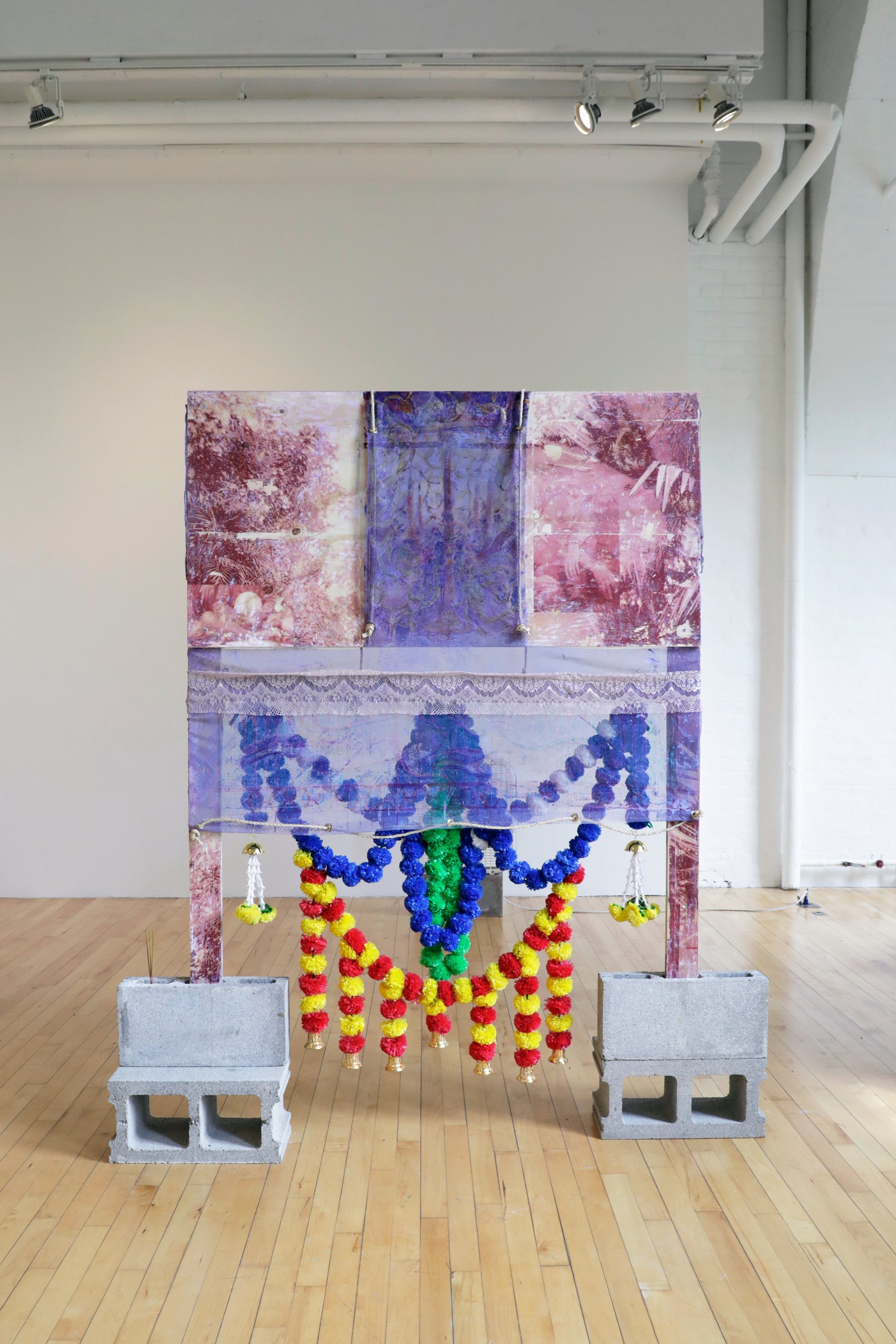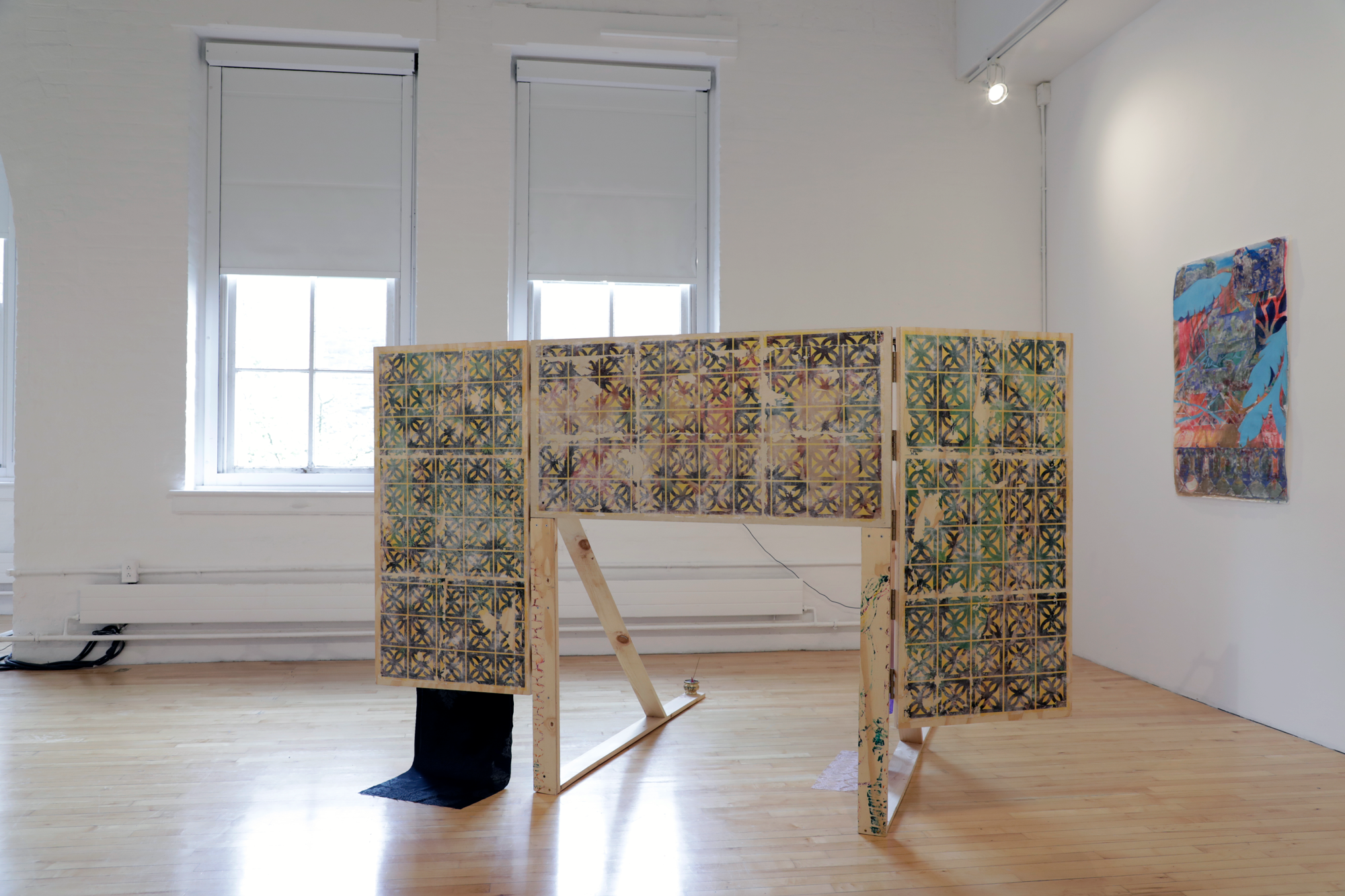i love the way you see the world, but why can’t you see me?
គ្រប់យ៉ាងក្នុងខ្សែភ្នែកអ្នកមិនមានខ្ញុំ
Exhibition Essay
Notes on Camp: (Dis)translation1 and affective labor through transient sites of home and memory in Khao-I-Dang Holding Center
By Sopheak Sam
✿✿✿
Exploring refugeehood and my family history, this exhibition incorporates photographs from my eldest brother’s personal collection of images capturing his time in Khao-I-Dang refugee camp as a teacher aide. The camp was a transient site of temporary resettlement (1984-1992) for my family after surviving the Cambodian genocide and fleeing to the border from the ensuing Vietnamese conflict and the enduring Cold War. My brother’s analog photographs are superimposed with my own digital iPhone images of Khao-I-Dang, upon physically returning there in November 2022 as part of my Fulbright Fellowship.
The work is driven by sensuous materiality (primarily concrete, wood, and paper pulp) and transient spatiality (memory and relationality) while using visual strategies of opacity and overlap (paint, fabrics, and inkjet image transfers) to reveal and conceal imagery of landscapes and bodies to destabilize time/space and renegotiate diasporic belonging. Breeze blocks, ironwork, and garlands reproduce allusions of globalized labor and postcolonial materiality that activates a haptic tension between hard and soft.
For this series, I engaged in a process of (dis)translating visual languages, such as "kbach" ornamentation, Khmer architecture, and vernacular Buddhism. This framework of (dis)translation borrows José Esteban Muñoz‘s concept of (dis)identification[2] and Homi Bhabha’s theorization on mimicry[3] wherein mimesis occurs through an attempt at replicating (i.e. doubling, mirroring, etc.) while resisting reproduction of form and processes essentialized as “authentic” — in turn, an aesthetic hybridity is synthesized through affective labor. With my hands, as with my immigrant parents’ hands, I honor this labor — by revealing image transfers through rubbings, sculpting paper clay made from personal ephemera, and building makeshift structures and impermanent sets that inevitably break down (particularly within this gallery context).
The work is driven by sensuous materiality (primarily concrete, wood, and paper pulp) and transient spatiality (memory and relationality) while using visual strategies of opacity and overlap (paint, fabrics, and inkjet image transfers) to reveal and conceal imagery of landscapes and bodies to destabilize time/space and renegotiate diasporic belonging. Breeze blocks, ironwork, and garlands reproduce allusions of globalized labor and postcolonial materiality that activates a haptic tension between hard and soft.
For this series, I engaged in a process of (dis)translating visual languages, such as "kbach" ornamentation, Khmer architecture, and vernacular Buddhism. This framework of (dis)translation borrows José Esteban Muñoz‘s concept of (dis)identification[2] and Homi Bhabha’s theorization on mimicry[3] wherein mimesis occurs through an attempt at replicating (i.e. doubling, mirroring, etc.) while resisting reproduction of form and processes essentialized as “authentic” — in turn, an aesthetic hybridity is synthesized through affective labor. With my hands, as with my immigrant parents’ hands, I honor this labor — by revealing image transfers through rubbings, sculpting paper clay made from personal ephemera, and building makeshift structures and impermanent sets that inevitably break down (particularly within this gallery context).
Through this embodied labor, I am mining the past/present/future as a site of simultaneity. I imbue color to refute pre- and post-colonial bifurcations of queerness, troubling this historicization as both/and. Constructed objects are queered through counter-progression: repetition, deferral, and dwelling to problematize them as neither functional nor futuristic. Forms open and close, landscapes reveal and conceal, figures disappear and reappear. Horizons and vanishing points obscure what lies beyond.
i love the way you see the world, but why can’t you see me? resists being and cruises inscrutable spaces of unknowingness and unnameability to reimagine counter-memorial possibilities of becoming.
This body of work takes pleasure in its ambiguity and sentimentality—evoking gates, doors, altars, and procession objects that demarcate boundary, loss, and longing for the impossibility of a memorialized past. This desire is felt through Chhun Vanna’s “Khao-I-Dang” (the lesser known song about the refugee camp; the more popular song being Keo Sarath’s ខាវអ៊ីដាងដួងចិត្ត khaav ʼii dang duongcet, lit. translation: “Khao-I-Dang My Heart”). I’ve recontextualized Chhun’s song as the exhibition soundtrack and into a video installation deploying karaoke script animation to underscore the poetic complexities and paradoxes of her lyrics on forgetting and remembering. The title of this exhibition i love the way you see the world, but why can’t you see me? additionally pays homage to the over-sentimentality of Cambodian love songs. Despite displacement and war, we still sing about love.
04.29.2024–05.9.2024
Solo exhibition in Experimental Gallery at Cornell Art Department.
i love the way you see the world, but why can’t you see me? resists being and cruises inscrutable spaces of unknowingness and unnameability to reimagine counter-memorial possibilities of becoming.
This body of work takes pleasure in its ambiguity and sentimentality—evoking gates, doors, altars, and procession objects that demarcate boundary, loss, and longing for the impossibility of a memorialized past. This desire is felt through Chhun Vanna’s “Khao-I-Dang” (the lesser known song about the refugee camp; the more popular song being Keo Sarath’s ខាវអ៊ីដាងដួងចិត្ត khaav ʼii dang duongcet, lit. translation: “Khao-I-Dang My Heart”). I’ve recontextualized Chhun’s song as the exhibition soundtrack and into a video installation deploying karaoke script animation to underscore the poetic complexities and paradoxes of her lyrics on forgetting and remembering. The title of this exhibition i love the way you see the world, but why can’t you see me? additionally pays homage to the over-sentimentality of Cambodian love songs. Despite displacement and war, we still sing about love.
04.29.2024–05.9.2024
Solo exhibition in Experimental Gallery at Cornell Art Department.
Image captions
Installation views, i love the way you see the world, but why can’t you see me?, Experimental Gallery, Tjaden Hall, Cornell University, 2024.
Footnotes
[1] Through a generative walkthrough of the exhibition space with Juliana Hu Pegues, Associate Professor in the College of Arts and Sciences at Cornell, I arrived at the juncture where Muñoz's conceptual framing of disidentification intersected with my own aesthetic strategy of “(mis)translation” as a non-extractive methodology in my research and studio practice. Juliana suggested that what I am actually engaging in is “(dis)translation.”
[2] Muñoz, José Esteban. Disidentifications: Queers of Color and the Performance of Politics. University of Minnesota Press, 1999.
[3] Bhabha, Homi. “Of Mimicry and Man: The Ambivalence of Colonial Discourse.” October 28 (1984): 125–33.













